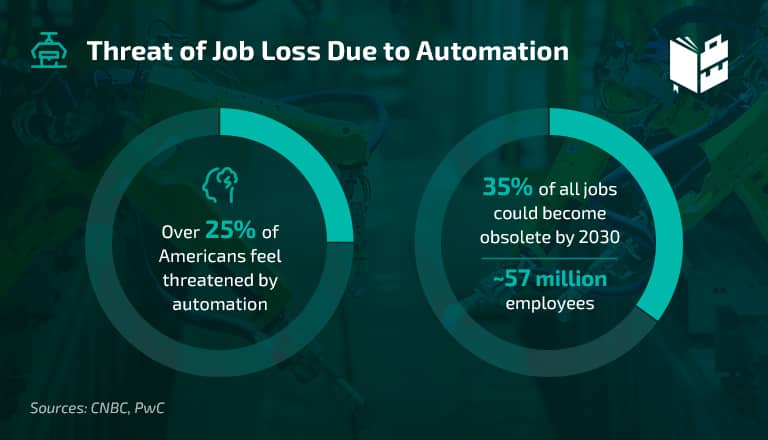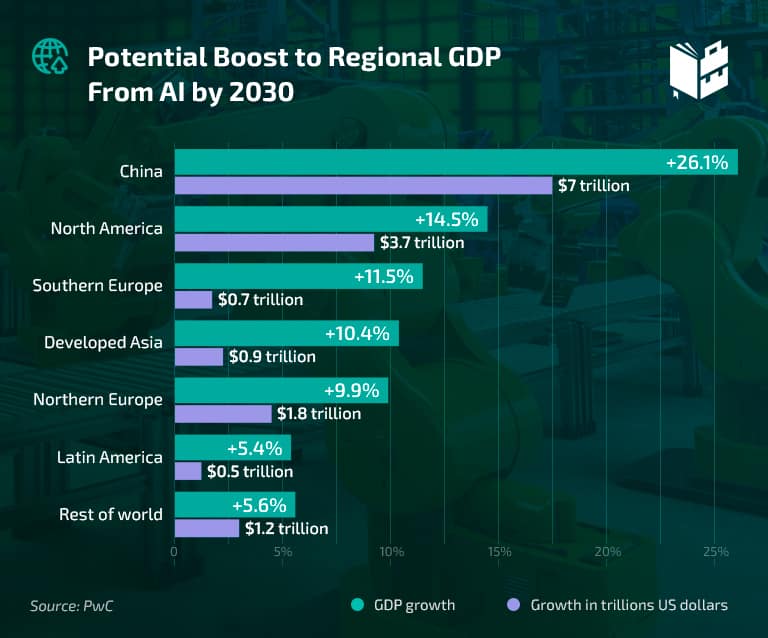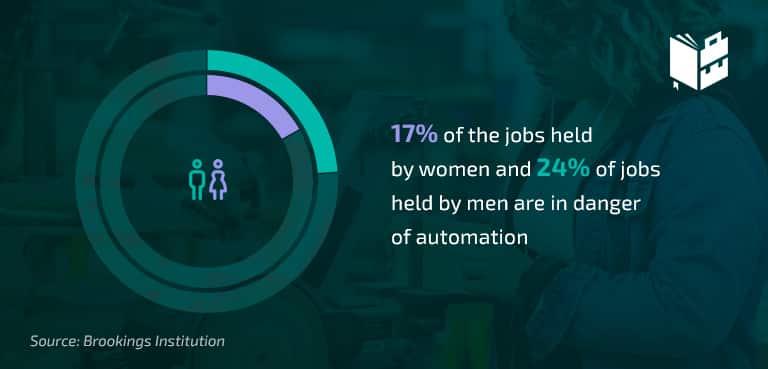New machines in the 21st century can create a problem with unemployment, as the people that lost their jobs need to find another vocation. Jobs lost to automation statistics show that some jobs disappear entirely, while others are just being reshaped under new conditions.
Researchers disagree on how automation will affect long-term employment. Some predict that the unemployment rate will rise, while others think the new technologies will bring new business opportunities and create jobs that didn’t exist before.
Automation and artificial intelligence are making progress on a daily level. New machines and computer programs are making jobs faster and easier, and we will see the massive impact of automation on employment in the years to come. Millions of people have already lost jobs in the USA.
So, what are predictions?
Read on.
Crucial Automation and Job Loss Statistics – Editor’s Choice
- One-fourth of jobs in the US are in danger of automation
- The number of robots doing human jobs increases by 14% each year
- Workers at junior positions face the biggest threat of automation
- By 2030, artificial intelligence is expected to add $15 trillion to the world economy
- 55% of the jobs that don’t require a bachelor’s degree are in jeopardy of automation
- One-third of jobs could no longer exist in the next 25 years
- 55% of workers think automation will boost their productivity
- Storage, manufacturing, and transportation are facing the biggest chance to be fully automated
1. Over 25% of Americans feel threatened by automation.
Most Americans say they feel threatened by new technologies. Research shows that 35% of all jobs could become obsolete by 2030. Speaking in numbers, 57 million employees might face job loss.

2. Almost 40% of people fear losing their jobs because of mechanization.
Automation and job loss statistics show that people are more and more concerned about losing their jobs to automation or robots. The number of worried workers has increased by 4% since 2014.
People think that every business is at risk, not just the jobs that don’t require education. However, the majority of them also think robotics and automation could never replace a human being.
3. Every year, 14% more robots start performing some human jobs.
When talking about jobs lost due to technology, we can’t ignore the increased utilization of robots in almost every industry. New discoveries speed up this course, and the predictions are that the number of robots will go up even faster.
4. More than half of employees think the primary goal of automation is productivity growth.
When it comes to automation and jobs, almost 60% of workers think that automation will help them be more productive. Also, analysis shows that business owners want automation to improve their employees’ productivity, reduce risks, and avoid mistakes. Only 11% of employers want to use new inventions to replace human employees.
5. 70% of employees would work on themselves to upgrade their professional skills.
Data on jobs at risk of automation reveal that people consider improving their skills just to retain their jobs. 70% of people are willing to do whatever it takes to stay as competitive as robots.
6. 55% of workers will need upskilling or reskilling to keep their jobs.
Technological improvements don’t only affect automation and job loss, but also people. More than half of workers will have to gain new skills, and almost 35% will have to take courses. Many will have to significantly improve their skills to retain jobs.
7. Three industries are facing the chance to be fully automated – storage, transportation, and manufacturing.
No one can precisely tell how many jobs will be lost to automation, but research from 2017 suggests three waves of automation will influence various industries. Some industries are at greater risk than others. For example, one of the waves will be the period when improved computer programs outperform people in data analysis.
The augmentation and the independence rush will hit industries such as storage and transportation, and the same thing will happen to manufacturers. The construction industry is one of the jobs at risk of automation, as well.
8. AI will most likely add $15 trillion to the world economy by 2030.
The GDP growth is predicted to be vast. It will increase by 25% in China and 14% in North America. A big part of the profits will come from product improvements, and automation will increase the affordability and attractiveness of the product, as AI replacing jobs statistics show.

9. 55% of vocations that don’t require a college degree could easily be automated.
Administration jobs and manufacturing will proceed to be at the greatest risk of mechanization in the next few years. All the positions that don’t require a college degree are at high risk, as well.
Robots will do one-fourth of these jobs. Also, almost 80% of food preparation jobs could be automated. Jobs lost to automation statistics say these jobs are in sharp contrast to careers such as psychology or education.
10. Rural parts of Europe and America are at a high risk of job loss. Alabama and Arkansas show the potential risk could be higher than 65%.
Big cities on the east and west coast of the US are booming because the IT sector is located there. Automation and artificial intelligence will most likely bring new job opportunities for the people in these areas.
At the same time, states in the heart of the US will face the risk of job loss due to automation because people in rural areas won’t be able to find a new vocation as easily. On top of that, they mostly work in industries like transportation and agriculture.
11. By 2022, jobs done by humans could drop by more than 10%.
Nowadays, people do 70% of all tasks, while robots do the rest. If these unfavorable unemployment trends continue, predictions are that humans will be doing less than 60% of the work in the future.
Automation replacing jobs will be evident, especially in information technology. What’s more, it will take one share of communicating and coordinating.
12. 17% of the jobs held by women and 24% of jobs held by men are in danger of automation.
This gap is so great because more men work in production, manufacturing, or transportation. Men dominate industries such as building and installation, and they are at the highest automation risk level. Most women work in professions that are at low risk of automation.

13. Workers aged 18 to 25 are at a 50% automation risk.
Junior positions are the easiest to be replaced. Older workers (up to 54 years of age) face a 40% automation risk. Younger workers perform highly repetitive tasks. They often work in the food service and preparation industry, which is highly rated by the jobs automation risk calculator.
Young workers make up 10% of America’s workforce, but they hold 30% of food prep and service jobs, and robots can easily replace them.
14. One-third of current jobs didn’t exist 30 years ago.
Automation doesn’t always entail job loss or low productivity of human workers. Sometimes, it leads to automation job displacement. Workers also tend to think that automation will bring them new job opportunities and higher salaries.
Employees are willing to learn new programs and acquire new skills if that means they will find a new job easily. On the other hand, economists think modern automation is different and that its main goal is to displace rather than improve humans’ work. That means there will be more jobs lost to automation by 2030.
15. Robots could take over 20 million jobs in the next decade.
Each robot can do what 1.6 human workers can. That means that millions of employees could be replaced in the next ten years. Regions that are marked as low-income areas will experience a greater impact of automation than high-income regions.
16. Purchases of medical robots increase by 50% every year.
By 2050, the need for investment in healthcare will increase. Robots that work in medical services are now worth $2 billion.
17. Automation can boost global GDP by 1.5% every year.
Although jobs lost to automation statistics show that many workers could lose their jobs, it can positively influence the global GDP. However, employees who lose their job would need to be employed again to sustain long-term economic growth.
18. Seven million people in America lost their jobs in the last 15 years due to automation.
When automation started influencing production, citizens gained access to cheaper products, while large workforce sectors were left jobless. Once they can find new jobs, they face a reduction in wages of up to 30%, automation and job loss statistics show.
19. Two-thirds of workers think automation will bring them better jobs.
The International Federation of Robotics found that, even though the number of jobs lost by automation keeps rising, people are still very optimistic about the benefits it could bring. The survey found out that workers that are at the greatest risk hope to get better employment.
Jobs Lost to Automation Statistics — Conclusion
Automation is one of the most powerful forces that have been changing and reshaping the modern world. Every similar change has brought great disturbances to how the market works and the sort of businesses that people do.
Artificial intelligence and robotics will eliminate some jobs and create a better work environment for everyone. People will be educated in fields such as computing and design. Robots will take over manual labor, and people will do jobs that require more critical thinking and planning.